Testimonies
Here is a selection of testimonies submitted to us via e-mail or Facebook, and originally published on our Hungarian-language website. These testimonies were selected and, unless stated otherwise, translated into English by Gwen Jones. To submit a story, please write to bertalan@ceu.edu.
2014. June 19., Thursday

A special “protected house” in Budapest
I am a Christian and was born in 1934. My father was a trouser tailor working from home for what I think was the largest tailoring company in Budapest before the war, the English gentleman’s fashion tailors HERMAN STAUB, who was Jewish. Numerous actors, politicians and other famous people were regular customers. I remember one or two, [actors] Pál Jávor, Andor Ajtai and Gerő Mály, but also István Horthy too. The tailor’s operated in the fifth district on the corner of Semmelweis and Gerlóczi Street. Today it’s the branch of some bank. We lived in Rákospalota. Together with his older brother and my grandfather, my father made trousers for the company where 25-30 people worked. From the age of 8, I would deliver the finished items then bring home the material for the next batch. I was constantly in touch with Uncle Staub and his whole family, who lived in the house next door on Semmelweis Street. Our friendship was mutual, they liked me, the worker’s son, and I liked them, the lovely, kind-hearted auntie and uncle who gave me sweets.
In the spring of 1944, the salon moved into the house on the corner of Semmelweis Street and Kossuth Lajos Street, above what is today the Puskin cinema. Later, I think it became a fencing club. But it wasn’t only the Staub salon that moved into these new premises, but also 2-3 Jewish tailors employed in the workshop (the non-Jewish employees stayed at the original workshop), as well as other Jews who worked in Budapest as tailors, cobblers, milliners and undergarment makers. Naturally, the owners of such Budapest salons were Jewish too. And here, a civilian clothing salon opened which served the German soldiers, officers and diplomats, from head to toe, with clothes, shoes, undergarments and caps. Of course this was a completely closed shop operating along the lines of discretion, and its head was Herman Staub.
I learned from my father that the Germans were clothed for free, and in exchange, the Jewish laborers and their families were exempt from every Jewish law in force at the time. Family members were put in the neighboring house on Semmelweis Street, which was not as overcrowded as the yellow-star houses would later be, but acceptable, although the residents lived in less comfort.
I recall that this lasted until approximately November, or at least I took deliveries there until then. After liberation, Staub and family opened up their old salon, moved back into their old apartment, and survived those terrible times in one piece, in this special GERMAN PROTECTED HOUSE. I learned from them later that in the last few weeks and days before liberation, when the Germans were surrounded at the Buda Castle, the Staub family had to go into hiding too. They were in great danger as the Germans could no longer protect them against the Hungarian Arrow Cross.
I’d only note that after liberation, the company’s customer base changed insofar as instead of István Horthy and the other politicians, people like Zoltán Tildy, Ferenc Nagy and Zoltán Vas took their place. They also had to flee nationalization (I think with the help of the new generation of politicians), and at the last moment, in 1948, the whole family moved to Argentina.
Respectfully,
Ferenc Gajer
Retired engineer
2014. June 18., Wednesday
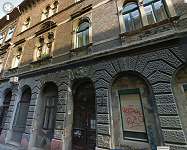
One Quarter of a Square Meter
A novella
I have been living in a house in Terézváros for over a generation. It is an old house full of secrets, not far from the Opera House on Andrássy Avenue: an area of downtown Budapest that was once beautiful. My family is half-German which is why for me, next to Hungarian, German is one of the most beautiful languages.
There probably aren't many others who feel this way.
Auschwitz-Birkenau, Dachau, Buchenwald.
I can pronounce them perfectly if I need to.
In one of the world’s most beautiful languages, the world’s saddest words.
A good few decades ago, Aunt Rózsi S. lived with us in a twenty-square meter section of living space, with a shared kitchen and bathroom. This was all she had, and with calm good humor, she observed life.
Aunt Rózsi was a Holocaust survivor. Her husband, son and entire family were among the first to be deported and then entrusted to the winds from the death camp crematoria of one of the small towns whose names demand accurate pronunciation, and where, according to the inscription above the main gate, work makes one free.
I can remember her from when I was a four-year-old boy. She was a short lady with smiling eyes, in a silk dressing gown. She would often invite me and my mother in for a little snack. She regarded my mother as her daughter, and me as her grandchild.
I loved her very much, but mostly the frothy cocoa (which was a still a rarity in those days), the jam-and-chocolate Sacher cake, and the many delicious almond-walnut cookies. She and my mother would talk a lot, while I just munched as much as a I could.
Which was everything on the table and twice that again.
Other than the wonderful feast, the only thing that held my attention was a yellow star sewn onto her simple dress hanging on a clothes stand. It was a beautiful, regular, six-pointed geometric object. As a child, I probably didn’t understand why it wasn’t shining in the sky with the rest of the stars.
Aunt Rózsi saw how curious I was, and told me a story which enthralled me as a small child.
The star was the eternally beating heart that belonged to a queen who lived long ago, and which quietly observed people’s thoughts in the world. Whoever was in trouble or felt that they were very alone would receive a visit from the star, who would knock quietly, say hello, and then start talking. All their dear memories, and friends and loved ones they hadn’t seen for a long time would suddenly appear around them, and all the sadness would come to an end. The star would never leave them ever again, would always cry with them in times of sorrow and console them, so that later, they would be happy once more. The star would warn them at every bad thought, embrace them at every good thought, and praise them.
In every happy moment, the star would be glad with them.
But Aunt Rózsi told my mother an entirely different story.
A story my mother only told me when I was at high school, when I often slid under the bench in a torpor during history classes and their sterile, lifeless and pointless texts, overheated with ideological humbug.
One tiny episode, which one only needs to hear once in order to never again want to think of war, genetic or racial classifications, or any other similar half-witted, epoch-spanning evils.
*
During the 1940s, our house was a “yellow-star house” and part of the ghetto. People of the Israelite faith and of Jewish origin from all different parts of the city were moved in here.
In today’s world, which falsely describes itself as perfect, we could only describe it as a coolly elegant, correctly efficient, working logistical center.
A storage complex for processing people.
Putting aside the cool elegance which did not in fact originate from the basic nature of those figures with Arrow Cross armbands reigning at the time, all necessary criteria were met.
Those “human goods,” which later ended up in cattle wagons, were still displaying signs of life; the effective budget optimization; the appropriate place; and the planned itinerary.
The kitchen, front room, and bathroom parts were called “demonstration, goods movement” sites. The large room functioned as a depot for the Arrow Cross armbands with their black uniforms, and the occasionally present “foreign consultant”—a different sort of uniformed, armband “expert”—while the smaller rooms were used for storing “human goods” in sixty square meters.
Multiplied by its four-meter height, the sixty square-meter “functional” site meant 240 cubic meters of air. The maximum storage capacity can easily be worked out, if we know the average breathing frequency of a human being, and the volume of gas exchanged per minute in the lungs.
The “foreign experts” clearly had some sort of calculation for this, but treated the Jewish people as beings inferior to those who belonged to the homo sapiens race, and didn’t go to much trouble over them. They left it to a much simpler equation. “Vier Juden, ein Quadratmeter,” in other words: four Jews, one square meter.
Thus one person was entitled to a quarter of a square meter.
It’s difficult to comprehend this in sound mind.
Aunt Rózsi said that in the room where she was, of the people crammed into twenty square meters, a minimum of two or three would die each day. The soldiers in charge of forced laborers would, in the best instance, take the trouble to remove the dead on a daily basis, in the worst case, every two to three days. They threw them downstairs, and then somebody carted them off somewhere in a wheelbarrow.
They lived for many days like this, hungry and thirsty. Sometimes they sprinkled some water in over them, which meant they were able to drink and wash a little. In the place of the dead, they always brought new living people, and the increasingly unwell victims just waited for their turn.
When would lurking death come, immediately, or in the uncertain future?
As the Russians approached, the deportations were accelerated. One winter’s day, the guards and house supervisor herded everyone outside, and so they set off.
But the remainder were not taken towards the railway station.
Aunt Rózsi doesn’t remember exactly how she escaped from the line of people being marched towards the banks of the Danube. She mentioned an artillery grenade striking the cobblestones, and a drunken Arrow Cross guard who wasn’t paying attention, but it doesn’t make any difference now.
She took part in the reconstruction of the country, returned to her apartment at Vasvári Pál Street 9, and lived on quietly. New uniforms, new armbands, new marching songs arrived.
And a new symbol too, in place of the old swastika and arrow cross.
A star. It had only five points, and was completely different in color and nature from the six-pointed star sewn onto simple clothing. A furious, merciless red.
Aunt Rózsi did not remarry. She worked as a secretary in the new world ruled by the arrogant five-pointed star. Once a week, whenever she could, she would go to the Lukács baths, and the Gerbaud café with her girlfriends.
She never exchanged the little yellow star for the other one.
When she died, the star disappeared in the packing. If I had still been four years old, I would have thought that it returned to the sky to its friends.
But I’d already turned fifteen.
*
They say that times is the only true judge in the world, and only time will decide what is important, and what wasn’t true.
So maybe we can breathe out. Monstrous ideologies that make everything uniform, with all their outfits, armbands and symbols, have worn out and died.
Probably.
It occurs to me sometimes that maybe it’s not like this after all. It’s possible that the old demons have just changed their clothes, as they’ve done so many times before. They are hiding sneakily, preening themselves, then jostle one another in front of the mirror, trying to flatter us.
Aunt Rózsi would definitely recognize them.
She would see—and I hope I’m wrong—that the commanding officers in boots and military uniform with their sick-minded armed men had changed into elegant gentlemen redeeming the world, dressed in fine suits and ties.
Into all-knowing, great guys.
In place of the old leaders step expert sorcerers with their new external appearance, and just multiply in number over the face of the globe.
Global development is, after all, unstoppable.
*
I’m watching some cheerful hotheads on television. They’re cute. Want to break some Guinness record. There’s this small car, and the aim is for as many of them as possible to get in. They slide and scramble all over each other’s backs, all smiling countenances from inside the windscreen.
They wave and chortle, as much as is possible. They’ll be able to escape any minute now from this crush, crack open the champagne, and win.
After brief discomfort comes unadulterated happiness. Life is one great big horsing about.
*
Sometimes, when I’m alone in my room, which was once Aunt Rózsi’s, I experience for one moment what it must be like to be one of the 80 people in this twenty square meters. Perhaps, because of the furniture, there were only forty to fifty people. It’s a reasonable assumption.
But because of the evil, it might have been more than eighty.
I am there among them. One can’t sit or lie, but just lean up against one another as one dying mass, muttering curses or prayers as we grasp for air.
The stench of excrement and corpses spreads. For some time now we have been mere ghosts, but we still want to live.
Auschwitz-Birkenau, Dachau, Buchenwald.
I can pronounce them perfectly if I need to.
In one of the world’s most beautiful languages, the world’s saddest words.
One quarter of a square meter.
It would be better to forget, but that’s not possible.
We won’t escape from these clutches.
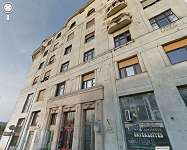
The Palatinus houses were built in 1911 at the Pest abutment of Margit Bridge, on today’s Jászai Mari (previously Crown Prince Rudolf) Square. The U-shaped block was made up of five houses: Jászai Mari Square 5 and 6, Pozsonyi Road 4, and Katona József Street 26 and 28. On the Danube bank side, between the two wings of the U was a French courtyard. With the exception of Jászai Mari Square 5, in 1944, all the houses became yellow-star houses.
I lived with my parents in a two-room apartment at Jászai Mari Square 5, and we had to move from here on June 24, 1944. Our designated residence was the two-room apartment which belonged to my grandmother, Mrs. Arnold Schwarz, at Jászai Mari Square 6, on the fifth floor. Besides my grandmother and us, the five-member Szlovák family (parents, grandparents and one child) also moved in. There was one family in each of the rooms facing the courtyard, and my grandmother lived in the maid’s room. There was a separate bathroom, WC, kitchen and pantry which, given the circumstances, was an acceptable arrangement, although of course, there were frictions, in particular over use of the kitchen.
In the five-story house there lived original residents, and Jewish families who had been moved in, but there were some exceptions too. For example, on the second floor lived a long-term resident, Dr. Pilis, a medical officer, with his family, and on their door was written “No Jews live here.” Similarly, the house supervisor, Mihály Ivanovics and his family also remained; I don’t remember whether he behaved differently towards the Jewish families after the occupation.
My father’s sister and her husband, the lawyer Dr. István Varannai, lived on the first floor. In their six-room apartment, a Christian lawyer (Dr. Endre Jankovits) had already been renting two rooms as office space for a long time, and my uncle’s secretary, Mrs. Tibor Barta, moved into one room with her mother, while in another room was the childhood friend of my aunt. The fourth room had my uncle’s younger brother, the economics journalist Dr. Aurél Varannai, who lived there with his wife and 11-12-year-old daughter.
Next to us on the fifth floor was the furniture trader Elemér Goldner, together with his wife and their 8-year-old daughter Vera, who was the same age as me; another family had been moved into one of the rooms in that apartment, with a son who was about the same age as me. Opposite us in the apartment looking onto Jászai Mari Square was the singer Erzsi Gervay and her daughter Marica, an actress; with them lived the well-known comic Ferike Vidor. There were probably other residents there too, but I don’t remember their names.
On the fourth floor, the offices of the Palatinus Construction and Real Estate Inc. company were still in operation, and where Christian employees still continued to work. I don’t know who ran the company at this time; after the Germans entered Hungary, its owner, Miksa Schiffer, had committed suicide.
Oszkár Kárász lived on the second floor with his wife, but I don’t remember any other names.
The bombings started over the summer, and in the evenings we didn’t get undressed, but would go down into the basement air raid shelter when the siren started. My mother brought with her the most important papers, and perhaps some food, in a small lacquer suitcase. The basements in these houses were one-and-a-half floors deep, and in the circumstances, were considered bombproof. We sat down here on simple benches until late evening, when the air raid sirens stopped. As far as I recall, these bombings lasted a few weeks and then came to an end.
One could leave the house during the day, we had some food ration tickets to shop with. Wherever there were men at home, it was usually them to who went down to shop, but in many families, the men were on forced labor service, and so the women had to take care of everything.
For me, the summer passed uneventfully, and I played in the corridor with the children living in the house; by that time, we were no longer taken down to the playground in front of the house. Over that summer, I didn’t go out onto the street even once. At the end of August, my parents received an “Exemption certificate” from the prime minister, which meant that we were exempt from the directives against Jews, although this did not extend to the race and property laws. I think my father applied on the basis of his First World War decorations and ensign rank, and his application was successful. In possession of the exemption certificate, my father submitted a petition for us to move back into our old apartment, where an Arrow Cross party member was living. He received the permit, which was valid until the end of September, and I think that after much haggling, we moved back at the end of September into the maid’s room in our old apartment. The first thing my father did was to buy a radio. Without a radio or telephone, I don’t know how we would have known anything about what was happening in the world.
On October 15, we heard Horthy’s proclamation on the radio, and then Szálasi’s takeover of power. My parents were completely at a loss, but the next day it became clear that we would have to return to the yellow-star house. In the meantime, the family of five had disappeared from there, and my father’s sister had also left with her husband. It turned out later that my parents knew who had arranged a hiding place for them.
On October 19, the Arrow Cross arrived in the house in the morning, and ordered all the men down into the courtyard, and took them away, including my father. We later learned that they had been taken to the Óbuda brick factory (where Oszkár Kárász, who was diabetic, took poison and died), and from there on a forced march to Hegyeshalom [at the border with Austria].
A few days later, the Pest side of Margit bridge was blown up: we saw the bridge, the tram that plunged into the river, and the corpses floating in the water from the window of an apartment facing the square: they were unforgettable sights.
In the meantime my mother tried, in my father’s absence, to acquire some form of protection document. The Swedish Embassy rejected her request, but she managed to get hold of a Swiss protection document for the whole family.
A few days later, the Arrow Cross came back to the house again, and ordered all the women and children down into the courtyard, which could have had all kinds of terrible consequences. First of all they took us to the yellow-star house opposite at Rudolf Square 1, where the apartments were empty because they had already taken the Jews away. Lots of people ended up in each of the apartments here, and nothing happened until dawn the next day when, while it was still dark, the Arrow Cross banged on the doors for everyone to go down into the courtyard. My mother asked one of the Arrow Cross men what would happen to the children, and the reply was that they would be taken care of. Upon hearing this, my mother fainted; two men caught her and took her into one of the empty apartments, and I went after her, they didn’t stop me. When she came round, my mother said I shouldn’t respond to any knocking or rattling at the door; and this is how they looked over all the apartments but didn’t enter, and so it was there that we stayed. When everything had fallen quiet, we simply returned to the apartment on the other side of the square, and were very lucky in that nobody saw us.
Katona József Street 39
In November, my mother received a “referral” to the Swiss protected house at Katona József Street 39, and we moved in without delay. We took with us rucksacks packed for every eventuality, and three mattresses somehow came with us too. We were lucky to be able to move, three of us including my grandmother, into the maid’s room. There were 19 people in the rest of the apartment, lying on one another’s backs, small children sliding about on the potty, with a long queue for the WC. From time to time, groups of people from other houses arrived in the courtyard. My mother cooked soup in a washing pot, which we took down into the courtyard to distribute to the incomers, who were freezing from the cold.
With the help of influential acquaintances, my father was allowed to return from Hegyeshalom, and could spend a few days with us. On November 29, the Arrow Cross knocked at the door once again, and these weren’t adults but young lads, they tore up the documents we handed over, ordered everyone down onto the street. We stood there with our rucksacks for hours, and then we were taken to the Danube banks at Újpest by Sziget (today Radnóti Miklós) Street, where once more we stood in line for a long time. My grandmother attracted the attention of a policeman, my mother gestured to me to remove my rucksack, and without saying goodbye, we left. My mother’s older sister lived at Újpesti Embankment 5, where the concierge let us in somehow, and from there we left the next day for a friend’s place, where we hid with false papers. My father was taken to Buchenwald, and we never saw him again.
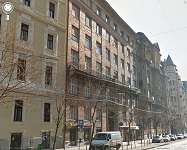
We moved with my mother and grandfather from Falk Miksa Street to Személynök (today Balassi Bálint) Street 27, a yellow-star house. My mother and I had a room in Aunt Mári’s apartment—she was from Balatonfüred—and the other room was taken by another Balatonfüred family. My grandfather stayed in the maid’s room.
The three families liked one another, and we never argued. There was not one man around, my father was interned at the Csepel internment camp until he was deported on June 16, and the other two men were on forced military services. They visited their families twice, but of the three heads of the families, not one survived the following months.
Gendarmes would continually “visit” the house to gather up the women aged between 16 and 40, and the man aged between 15 and 45. We were not in this category (since as I mentioned above, there were no men in the house, with the exception of one older gentleman), still, the gendarmes took caught they could find, and took them away. The Arrow Cross came too, even before the Arrow Cross takeover of power, to hold “house searches” (they were looking primarily for money, but we didn’t have any).
We constantly talked about when they’d “take us away” somewhere, and where to. Some hoped that they’d take us away to work, but even at the age of 14 (I turned 15 in the yellow-star house, although nobody noticed, not even me), I always said that if we went where they wanted to take us, they’d kill us.
We could leave the apartment for 2 hours a day, except for on Jewish holidays (during the Lakatos government). Whenever all the non-believers went to synagogue, we went to one in Buda so that at least we could cross a bridge for once. In my excess “free time” (what a strange word, when there remained no trace of freedom), I always read, of course, mostly poems, and especially Ady. And we dreamed together. In the meantime, we “got to know” one another in the very narrow basement reserved for Jews during the countless air raids, mostly at night.
We didn’t have a radio, of course, but next to our room there was a maid’s room, where a very sympathetic maid lived. She turned her radio up so it blared out, and by putting my ear to the wall, I could hear everything. I heard concerts, news of the Allies’ Normany landings, and finally Horthy’s proclamation too, of which I remember every word. We often hoped we’d survived, and that our fathers would return, but this hope always quickly disappeared.
On October 15, Gyuri Litván who lived in the house with his two brothers) tore the yellow star off the front of the building, until the Arrow Cross concierge replaced it in the evening, after Szálasi had seized power.
We had to leave the yellow-star house quickly, and move to the ghetto.

I was four years old when I ended up at Erzsébet Boulevard 50, as a yellow-star house. The three of us “lived” on the third floor with Lajos Herceg and family. My mother, older brother and I survived. But in January 1945 my grandfather, Géza Szántó, was shot in the stairwell by an Arrow Cross lad because this 80-year-old, weakened man had “slowly gone downstairs” during an air raid. He died right there, in this yellow-star house.
2014. June 17., Tuesday
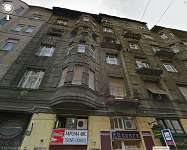
My great-grandfather, my grandfather (Félix), and my mother (Vera) lived for a while together with their cousins Kati and Imre who had fled the Germans in the countryside, in Csanády Street 18. The last time they were in Budapest was in 2002, when they told their story.
Kati was nine months pregnant when she arrived from Tokaj, as the local gendarme had warned her to flee. Imre was on forced labor service. My mother was working with false papers as a domestic maid in the 6th district. “It was a Jewish house. We had to move in together. We were fine, there were special problems, but then… they came, and all the men had to go down into the courtyard. They were taken away. They didn’t say where to, but everyone knew it was towards the water, the Danube… When they came into the flat up on Csanády Street, they took Uncle Félix away… and later returned, the women had to leave too. And there was my baby in the middle of the room. There was a carry-basket, and when the poor girls had left, and everyone else from the house, two Arrow Cross men came up stairs to check everything, and see whether there was anyone left in the apartments… and there I was with the child. The two Arrow Cross men—actually they were about 18, lads—asked why I hadn’t gone downstairs. I said, sorry, but I can’t go downstairs with this baby, and at this, they left. The child was two months’ old.”
Later, Kati left for Canada with her husband and two children, while Imre went to Israel. My grandfather, Félix, disappeared without a trace. His name was not recorded anywhere, and his memory is only preserved in the family, and that one sentence from an eye-witness relative.
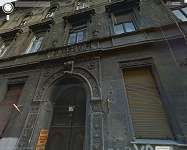
There’s an elderly lady still living in the house today, let’s call her Auntie Klára. She is 80 years old and has been living in the house since 1958, but it turned out that she’d lived here once before, during the war: she was forced here with her mother and younger sister because of the Jewish laws. The three of them were placed into a small second-floor apartment where there were so many others that there was standing room only. There was no WC, and you could only relieve yourself in a bucket. Only one of Auntie Klára’s ancestors was Jewish, and the other branch were “goys,” in fact there was an army officer in her family too. Auntie Klára and her family had already been living in inhuman conditions for weeks and months in the house, when this officer relative appeared, showed the guards a paper, took Auntie Klára, her sister and mother by the hand, and then walked out of the house with them, taking them to the basement of a house on Damjanich Street. From then on, they lived for months in the dark basement, right up until the liberation of Budapest.
It was only then that Auntie Klára learned that one day after their relative had rescued them from Kazinczy Street 7, everyone on the house was deported.
2014. June 16., Monday
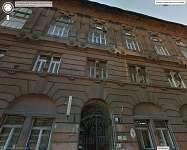
It’s sad that there are so few remembering the many yellow-star houses, and that among them, the number of people who were residents is tiny.
Four of us—my two aunts and one of their husbands—ended up in the yellow-star house which I already knew, since my older sister lived there with her relations. Eight of us shared a two-room apartment. The house was famous because it was where the Metropolitan Children’s Society (a Jewish foundation) had run a kindergarten for years, run by Auntie Manci (I don’t remember her surname, but everyone knew her). This is significant because sometime towards the end of the summer, the number of residents jumped suddenly with the influx of a large group of boys from somewhere in Sub-Carpathia, who had found themselves orphaned. Another group of children also found a place here, and they were Budapest children whose parents had been taken away from them after October 15 [the Arrow Cross putsch]. Lots of bunk beds were set up, and as an older boy, I lent a hand in this work.
Most of the residents were women—since the men were on forced labor service—and they became the employees of the Children’s Society, financed by the International Red Cross. By this time, the president of the foundation, Jenő Polnay, had already moved into the house, and everyone referred to him as “Your Grace,” because he had been a minister in the 1919 Friedrich government, which was in power for one week. The scarcity of provisions was eased a little by a Jewish forced laborers’ unit which had moved into the former dance school on the second floor, and whose “camp” kitchen provided the residents with some food from time to time. Following Szálasi’s putsch, they were driven out of the house.
“His Grace” took the “children’s home” in hand and oversaw the employees. After October 15, when the armed Arrow Cross men drove the women from the house to the nearby holding place on Klauzál Square to take them to build fortifications, he chased after them with the framed Red Cross document in his hand, and boldly demanded that the Arrow Cross leader release his employees. He succeeded that time. During a later “visit,” however, he didn’t. That’s when they also took one of my aunts who was seriously ill and, as an eyewitness later told us, after she collapsed on the highway to Vienna, she was shot in the head by one of the Arrow Cross lads escorting them. During the period of the ghetto, which was established in late November-early December, and which this house belonged to, the food provisions for the children and their adult guardians grew worse day by day. The ghetto had a central kitchen where we sometimes got food. I didn’t take part in these deliveries as a “courier.” Looking back today, it’s difficult to imagine that these dreadful soups were consumed right up until the last drop. Fevers were common. Given the lack of medical care and medicines, the below-minimal standard of nourishment as well as the terrible cramped conditions seem now unbelievable, and I can “only” remember the deaths of two small children. And then somehow January 18 came when, frozen and seriously traumatized, we were liberated at the yellow-star house on Akácfa Street 32.
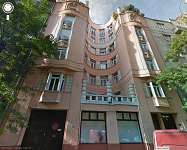
The story of the Falk Miksa Street 4 yellow-star house during the Arrow Cross era.
This unique, special story begins after the Arrow Cross takeover of power, and is closely connected with how Hitler's empire confiscated property in Hungary. Its antecedents, therefore, reach back to March 19, 1944. Of course, this applies to all the yellow-star houses, but the case of this particular house was a little different. I'll describe this based on my own experiences and knowledge.
When the German occupying forces arrived in Budapest, with them was SS Obersturmbannführer Kurt A. Becher, a lieutenant-colonel with a special commission. He was Himmler's economic adviser and later his economic deputy in Hungary. Working together with Eichmann who oversaw deportations, Becher's primary task was to acquire property belonging to Hungarian Jews (companies, stock, significant properties, cash reserves and so on) for Hitler's empire. Becher's greatest result was to acquire the enormously valuable industrial giant Manfréd Weiss. They gathered up all the transportable valuables too, and exported them from the country. One of these branches, which certainly represented the least value but which would probably positively influence the mood of the German population, was the supply of better quality foodstuffs and clothing by Christmas 1944.
In order to collect all goods to be transported (from Jewish businesses that had been closed, and from industrial workshops' storerooms), and to process certain raw materials into finished products, they used Jewish labor. For this purpose, storerooms and workshops were constructed probably from April 1944 onwards. After Szálasi came to power, sometime towards the end of October, professionally well-respected Budapest industrialists and traders were rounded up, together with their families. They were temporarily housed in first-floor premises of the Gourmand coffee house on Kossuth Lajos Street, which was also used to temporarily store the accumulated goods. One could sleep there on bales of cloth taken from the storerooms. The next day, the people who had been rounded up were crammed into Jewish apartments in the house at Falk Miksa Street 4. In these apartments then one could sleep on armchairs, carpets laid out on the floor, and blankets. The day of "billeting" had already been forgotten. But the "results" of Margit Bridge being blown up were certainly visible from the roof of this house.
Every morning, the adults (professionals and family members) were escorted by the SS to work. They were made to fill trucks with storeroom supplies. Materials to be processed were transported to workshops which made outer garments (coats, suits, women's dresses), underwear and clothes. There was also a bakery in the neighboring Személynök (today Balassi Bálint) Street, where milk-loaves, honey milk-loaves and Christmas tree decorations were made in large quantities. Family members were also taken here to work as assistants. The finished products from the storerooms and workshops then had to be packed onto barges on the Danube (and perhaps onto wagons too). They transported to Germany other foodstuffs too, potatoes, onions, flour, sugar, geese, ducks and who knows what else.
As the siege of Budapest reached Pest's inner districts, the bombings and gunfire meant that one had to spend the whole day (and of course the night too) in the basement, seeking some sort of protection. Down there, according to the decrees, Christians who remained in the [yellow-star] house were separated from the Jews. In between attacks, you could go up to the courtyard, from where everyone could quickly reach the basement again. The concierge's apartment opened onto the courtyard, and for a good amount of money, he allowed women into his kitchen to make tea, soup or other dishes prepared from basic ingredients acquired from the Germans.
In return for work, and obviously to maintain the "ability to work," the families were provided with certain foodstuffs. Moreover, they received things that most of the civilian population of the city outside the ghetto went without: bread, meat (and chicken!), potatoes and lard. An SS guard stood in the entrance gate to the house to keep watch over the workforce and make sure nobody disappeared. In any case, this wasn't "innocent," because the "brothers" from the nearby Arrow Cross house at Szent István Boulevard 2 came over from time to time to conduct raids, just like in every other (protected) yellow-star house in the Lipótváros part of town. Loud exchanges took place between the SS guards and the Arrow Cross raiders. The guards once even called the SS alarm to restore order.
Luckily, the "residents" of this house escaped, and were liberated here. The privileged circumstances of the house played a role in this lucky escape. When the SS special commando left Pest, a Wehrmacht guard was placed at the entrance to the house. They were probably counting on the fact that the SS would soon return, and they could continue their activities. Although the majority of SS soldiers were not a nuisance, the Wehrmacht men came down into the basement for friendly chats, since the adults spoke good German. They talked about their families and the hardships of war. Two days later, at dawn on January 18, they too left for Buda. They came into the basement late at night to "say goodbye," and then around dawn, armed Soviet soldiers appeared looking for Germans in hiding, and weapons. And then, a few days later, once armed conflict had diminished in the inner districts, one could leave the house and look up one's old place of residence.
2014. June 13., Friday
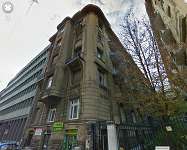
October the 15th.
Maybe it wasn’t the 15th. It could have been two days later. I was an eight-year-old child and didn’t pay attention to what day it was, but the story below relates to the day of the Arrow Cross putsch, the date of which I learned later on. In a third-floor apartment in the Jewish house on Bulyovszky (today Rippl-Rónai) Street where we lived after our forced move, the remainder of three families were living in three rooms. The husband and son of the lady who owned the apartment were on forced labor service, the latter at the infamous Bor copper mine. Auntie Olga had a heart condition and was bed-bound, I don’t know how she survived but she did. Then they moved away.
My cousin and family lived originally in the second room, but they soon realized and saw clearly that whoever wanted to stay alive had to do something, and they managed to leave with false papers for a safe hiding place. All my mother told me was that they moved out.
She too tried to sort something out: for that very day (how could she have known that this was when the Arrow Cross putsch would take place?) she managed to bribe an Arrow Cross man (where did she get the money from?) who was willing to take her—I remember for the sum of 100 pengő—out of the yellow-star house and escort her to the Swedish embassy. During those times, everyone expected their escape from the Swedish protection letters (for some it "worked," for others, the Arrow Cross simply tore their papers up. She stood in line there for the whole day, while the three of us waited at home: my mother's sister and the two of us children.
She had only just left when an Arrow Cross commando arrived in the house. They locked the entrance gates (Bulyovszky Street 38 was an U-shaped twin-block whose courtyard was sealed with large iron gates). They trotted all the way along the corridors, bursting into every apartment, and announcing that in under 15 minutes, we should pack a change of clothes, food for two days, and stand ready since they'd be coming back for us. My aunt started packing—I don't remember what or how, or in how many minutes—while we were completely frozen with fear. She put coats on us, attached the rucksacks to our backs and then, with a large packed rucksack on her back, sat down on the armchair while we stood in front of her, waiting. The two men in black uniform came back for us. They shouted at us to set off, but my aunt didn't move. They continued shouting and tugging her, she fell to the floor; it was obvious that she was unconscious (to be honest, I didn't really understand what was happening). The Arrow Cross dragged her by the arms as far as the door, where they dropped her, looked at one another, and left. That is how we remained alive.
Of those who were taken away then, only a very few came back.
I'll never know whether my aunt actually fainted, or whether she just brilliantly faked it. During the years when everything was hushed up, not once did we mention those days, or ever talk about it again.
After standing in line for many hours, my mother returned home, when the marching columns were already lined up in the courtyard, but had not yet set off. The Arrow Cross concierge was standing in the gateway, and when he saw me mother, he waved at her to disappear. You see, this sort of thing happened too.
My mother avoided the block twice as the forced march set off, and the Arrow Cross disappeared. All three of us were in the kitchen when she arrived. Closest from the corridor was the kitchen door, and she entered through this. "Are you there?" she shouted, almost screaming, and as soon as she saw us, she fell flat on the kitchen floor.
Two fainting fits in one day.
Not long ago I went back to the yellow-star house where I lived from the forced cohabitation until I ended up at the Sztehlo children's home in October. Someone was just returning home at the time and let me in, they were kind and sharing. So I could have a good look around and take some photographs.
Pic. 1-5: the house from the street. A patinated Terézváros duplex with a French courtyard, and iron gate and fence. Of course, in my memories, the courtyard was much larger, but plant life has grown a lot (I don't think there was any then, the courtyard was bare), and a huge tree covered the whole place. This is the courtyard where, one or two days after October 15, they lined people up to be taken away. I don't know how many of them returned, and I only know of two little playmates of mine from the apartment next door, whose last stop was Auschwitz.
Pic. 6: the entrance to the three-room apartment on the fourth floor (which wasn't such a lovely white back then): the owner was the Bergmann family, and the lady was my mother's classmate, and it's because we already knew them that we ended up here. The families who moved into the other rooms were: us, the Előd family (two adult women and two children; the four men of the family were on forced labor service, one of whom had already died in 1942 on the Russian front); and my cousins and their family, the Káldors (mother, grandmother, three children; the father was already a Russian PoW, but of course we didn't know that at the time). Not one of the men survived, of the women, only my aunt and her mother found refuge in the Regent house, where a German arsenal exploded...
Pic. 7: the corridor. One of the important scenes in our life. In the evenings, once the heatwave had died down, the corridor filled with people. In a row, we leaned our elbows on the wrought-iron railings and gazed hopefully at the "lightning flashes." Which meant: whether the flashes from Russian cannons could be seen coming closer or not. The bare firewall opposite has since become one floor higher, and so now there's no longer any "view."
Pic. 8: the corridor above the French courtyard. This is where the Christians lived. I think every floor had its own security person. On our floor, the Christian lady was very kind, she didn't chase away the children who were on a serious mission to listen in in front of Christian apartments to the radio, and learn of approaching bombing missions in time.
Pic. 9-10: the beautiful old wrought-iron lift shaft, which became renowned among us when we useless kids, to the horror of our parents, held sliding competitions down the smooth bannisters. (We didn't believe it was dangerous! We're holding on!)
A lot of other memories came back to me, but this is already enough for a simple commentary on one house.